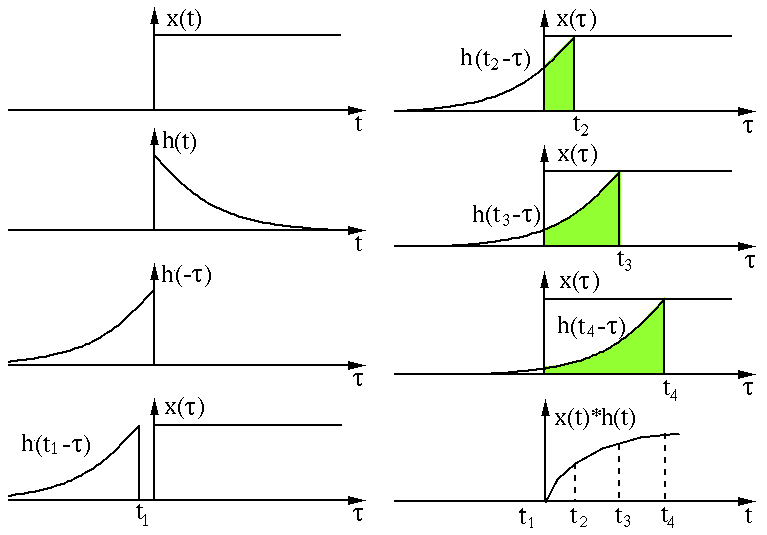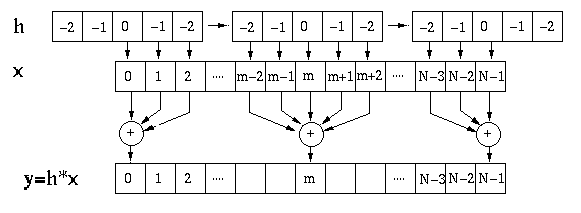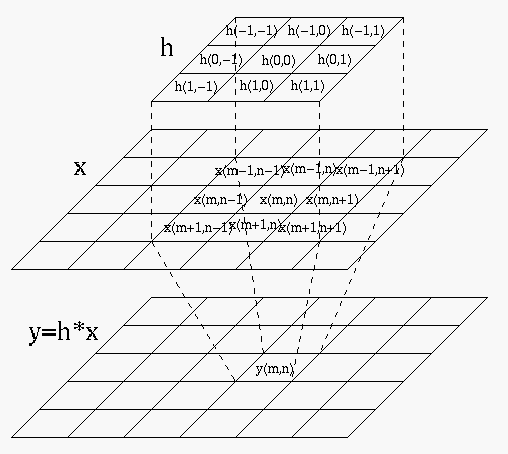Next: About this document ...
The convolution of two continuous signals 

 |
(1) |
 |
(2) |
 is the output of a system characterized by its
impulse response function
is the output of a system characterized by its
impulse response function  with input
with input  . For a finite
signal
. For a finite
signal  for
for  and a causal system with
and a causal system with  for
for
 , we have
, we have

 |
(3) |
Convolution in discrete form is
![$\displaystyle y[n]=\sum_{m=-\infty}^{\infty} x[n-m] \; h[m]
=\sum_{m=-\infty}^{\infty} h[n-m]\;x[m]$](img10.svg) |
(4) |
![$h[m]$](img11.svg) , the convolution kernel or
filter is finite and symmetric:
, the convolution kernel or
filter is finite and symmetric:
![$\displaystyle h[m] = \left\{ \begin{array}{ll} h[m] & \vert m\vert\le k \\ 0 & \vert m\vert>k
\end{array}\right.$](img12.svg) |
(5) |
![$\displaystyle y[n]=\sum_{m=-k}^{k} x[n-m] \; h[m]$](img13.svg) |
(6) |
If the system in question were a causal system in time domain
![$\displaystyle h[n)=h[n]u[n],\;\;\;\;$](img14.svg) i.e. i.e.![$\displaystyle ,\;\;\;\;h[n]=0\
;\;\;$](img15.svg)  |
(7) |
![$\displaystyle y[n]=\sum_{m=0}^{k} x[n-m] \; h[m]$](img17.svg) |
(8) |
If
![$h[m]=h[-m]$](img18.svg)


![$\displaystyle y[n]=\sum_{m=-k}^{k} x[n+m]\;h[-m]=\sum_{m=-k}^{k} x[n+m] \; h[m]$](img21.svg) |
(9) |
If the input ![$x[m]$](img22.svg)
![$\displaystyle x[m]=\left\{ \begin{array}{ll}
x[m]&0\le m<N\\ 0&otherwise\end{array}\right.$](img23.svg) |
(10) |
 in the convolution has to satisfy the following
for
in the convolution has to satisfy the following
for  to be in the valid non-zero range:
to be in the valid non-zero range:
 |
(11) |
 of the output
of the output ![$y[n]$](img28.svg) has to
satisfy:
has to
satisfy:
 |
(12) |
 in the convolution is equal to
in the convolution is equal to  ,
the index of output
,
the index of output ![$y[n]$](img28.svg) reaches its lower bound
reaches its lower bound  ; when
; when
 , the index of
, the index of ![$y[n]$](img28.svg) reaches its upper bound
reaches its upper bound  .
In other words, there are
.
In other words, there are  valid (non-zero) elements in
the output:
valid (non-zero) elements in
the output:
![$\displaystyle y[n],\;\;\;\;\;\;(-k \le n \le N+k-1)$](img35.svg) |
(13) |
Digital convolution can be best understood graphically (where
the index of ![$y[n]$](img28.svg)

We assume the input ![$x[n]$](img36.svg)
















In particular, if the elements of the kernel are all the same (an average operator or a low-pass filter), the we can speed up the convolution process while sliding the kernel over the input signal by taking care of only the two ends of the kernel.
In image processing, all of the discussions above for
one-dimensional convolution are generalized into two dimensions,
and 
![$\displaystyle y[m,n]=\sum_{i=-k}^k \sum_{j=-k}^k x[m+i,n+j] h[i,j]$](img45.svg) |
(14) |
